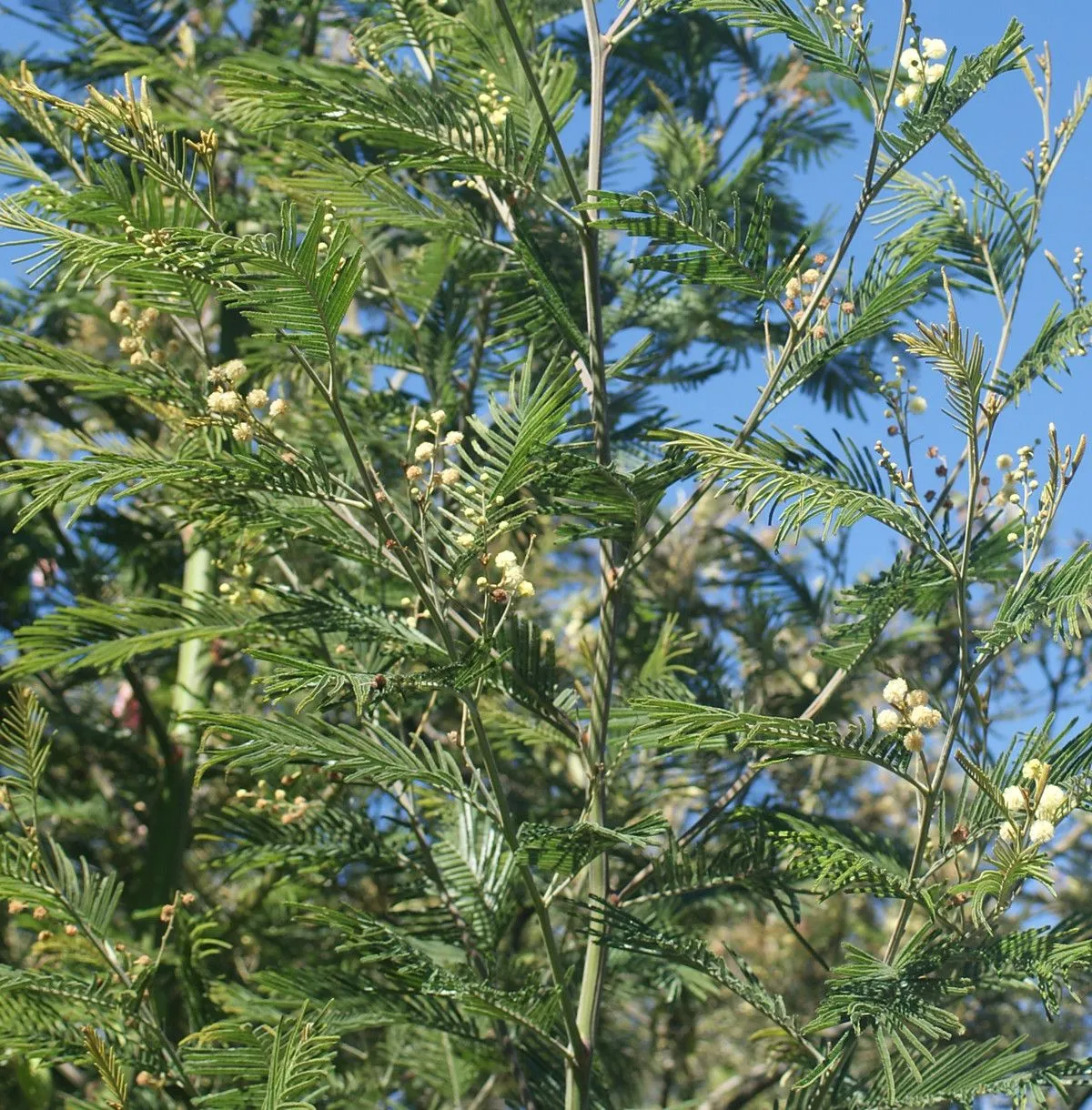
Author: De Wild.
Bibliography: Pl. Bequaert. 3: 61 (1925)
Year: 1925
Status: accepted
Rank: species
Genus: Acacia
Vegetable: Unknown
Observations: SE. Australia
The Black Wattle, known scientifically as Acacia mearnsii, is a prominent species within the Fabaceae family. Indigenous to Southeastern Australia, this remarkable plant plays a significant ecological and economic role within its native habitat.
First described by De Wild. in the comprehensive botanical catalogue “Pl. Bequaert.” in 1925, Acacia mearnsii has since garnered attention not only for its resilient nature but also for its utility. The Black Wattle is a fast-growing tree that can reach heights of up to 10-12 meters, characterized by its smooth bark and feathery, bipinnate leaves which are deeply divided into numerous small leaflets. During its blooming season, Black Wattle trees produce abundant clusters of small, golden-yellow flowers that give off a rich, sweet fragrance, attracting various pollinators.
This plant’s adaptability to different soil types and conditions makes it a common feature in its native Southeast Australian landscapes. However, its ability to thrive in a range of environments also contributes to its success as an invasive species in regions beyond its natural range, where it has been introduced for purposes such as erosion control and tannin production. The bark of Black Wattle is notably rich in tannins, substances that have been extensively harvested and utilized in the leather industry for tanning hides.
Ecologically, Acacia mearnsii offers several benefits. It serves as a source of food and habitat for local wildlife, while also playing a role in nitrogen fixation, enriching the soil in which it grows. However, its invasive potential necessitates careful management to prevent disruption to non-native ecosystems.
In summary, the Black Wattle or Acacia mearnsii stands out as a versatile and impactful species from the Fabaceae family, notable for its spectacular floral displays, ecological benefits, and economic value. Its origin in Southeastern Australia and subsequent global spread underscore both its hardy nature and the necessity for mindful stewardship of its proliferation beyond native bounds.
Ita: acacia mollissima
Eng: black wattle, green wattle, late black wattle, tan wattle, wattle
Deu: gerberakazie
Fra: mimosa vert, acacia noir
Spa: acacia negra, acacia-del-centenário
Por: acácia-negra, mimosa
Afr: swartwattel
En: Black wattle, Tan wattle, Late black wattle, Green wattle, Wattle
Af: Swartwattel
Ar: سنط رخو
Zh: 黑荆, 默氏相思
Cs: Akácie Mearnsova
Fi: Parkkiakasia, Parkkiakaasia
Fr: Acacia noir, Mimosa vert, Mimosa argenté
De: Gerberakazie, Schwarze Akazie, Australian acacia, Australische akazie
It: Acacia mollissima
Rw: Barakatsi
Ml: കറുത്ത വാറ്റിൽ
Fa: اقاقیا مرنسی
Pt: Acácia-negra, Mimosa, Acacia decurrens
Es: Acacia negra, Acacia-del-centenário, Zarza negra
Zh-tw: 默氏相思
Zh-hant: 黑荊
Taken Nov 6, 2012 by Tela Botanica − Geneviève Botti (cc-by-sa)
Taken Nov 21, 2014 by Tela Botanica − Liliane Roubaudi (cc-by-sa)
Taken Nov 21, 2012 by H. Goëau (cc-by-sa)
Taken Mar 9, 2021 by Thierry LE COM (cc-by-sa)
Taken Nov 17, 2014 by Tela Botanica − Liliane Roubaudi (cc-by-sa)
Taken Jan 19, 2022 by Raymond Hare (cc-by-sa)
Taken Nov 24, 2022 by remi guerrin (cc-by-sa)
Taken Mar 31, 2021 by emma mcmahon (cc-by-sa)
Taken Oct 25, 2022 by Kaori Kiwi (cc-by-sa)
Taken Feb 17, 2020 by ola pol (cc-by-sa)
Taken Nov 26, 2012 by J. Champ (cc-by-sa)
Taken Jan 22, 2020 by Karl Heinz Seidel (cc-by-sa)
Taken Nov 26, 2012 by J. Champ (cc-by-sa)
Taken Nov 21, 2012 by H. Goëau (cc-by-sa)
Taken Nov 21, 2012 by H. Goëau (cc-by-sa)
Taken Feb 18, 2020 by ola pol (cc-by-sa)
Taken Mar 9, 2021 by Thierry LE COM (cc-by-sa)
Taken Nov 26, 2012 by J. Champ (cc-by-sa)
Taken Nov 2, 2022 by Danielle Stig (cc-by-sa)
Taken Aug 23, 2021 by Gelo Cotán Jesús (cc-by-sa)
Taken Jun 20, 2019 by karinette rispalette (cc-by-sa)
Taken Jul 6, 2019 by Jose Manuel Azcona (cc-by-sa)
Taken Aug 23, 2021 by Gelo Cotán Jesús (cc-by-sa)
Taken Nov 21, 2012 by H. Goëau (cc-by-sa)
Taken Nov 21, 2012 by H. Goëau (cc-by-sa)
Taken Aug 12, 2017 by Tela Botanica − Sylvain PIRY (cc-by-sa)
Taken Oct 14, 2021 by Dominique Roberts (cc-by-sa)
Taken May 18, 2020 by Josefina Gomez (cc-by-sa)
Taken Oct 20, 2021 by av br y fac (cc-by-sa)
Taken Nov 28, 2015 by Tela Botanica − pierre marchand (cc-by-sa)
© copyright of the Board of Trustees of the Royal Botanic Gardens, Kew.
© copyright of the Board of Trustees of the Royal Botanic Gardens, Kew.
© copyright of the Board of Trustees of the Royal Botanic Gardens, Kew.
Family: Myrtaceae Author: (F.Muell.) K.D.Hill & L.A.S.Johnson Bibliography: Telopea 6: 402 (1995) Year: 1995 Status:…
Family: Rubiaceae Author: Pierre ex A.Froehner Bibliography: Notizbl. Bot. Gart. Berlin-Dahlem 1: 237 (1897) Year:…
Family: Sapindaceae Author: Koidz. Bibliography: J. Coll. Sci. Imp. Univ. Tokyo 32(1): 38 (1911) Year:…
Family: Asteraceae Author: A.Gray Bibliography: Pacif. Railr. Rep.: 107 (1857) Year: 1857 Status: accepted Rank:…
Family: Fabaceae Author: Medik. Bibliography: Vorles. Churpfälz. Phys.-Ökon. Ges. 2: 398 (1787) Year: 1787 Status:…
Family: Aspleniaceae Author: (Cav.) Alston Bibliography: Bull. Misc. Inform. Kew 1932: 309 (1932) Year: 1932…